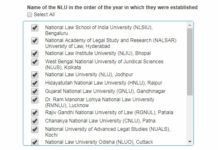Right. The notification for CLAT 2013 is out. HNLU has retained the old CLAT logo, which was used in the CLAT editions of 2008, 2009, 2010 and 2012. The website’s the same and not much has been changed with the procedure either. It is estimated that around 30,000 will fight for 1575 seats available in all of the 14 NLUs combined.
Anyway. So, what’s the deal this time?
The biggest change has been in the pattern. General Knowledge section, to be specific. Seems like they did listen to our open letter. You will now be asked static questions as well, alongside the current affairs ones. No time period has been mention to define what is and what is not ‘current’. (Unlike the previous two CLATs which stuck to ‘May to March’ period). The syllabi remains the same for all the other sections. So is the format of giving out your preferences of NLUs in the application form itself. (Unlike CLAT 2011 which had conducted counselling after the results were announced)
The second biggest change is that there would be negative marking of 0.25 marks per wrongly answered question. There. You cannot now draw a ladder and hope that your luck does the job. If you run out of time, you could mark some option randomly risking 0.25 if that doesn’t turn out to be the right one.
This table, taken from the CLAT’s official website, explains it all.
- Total Marks – 200
- Total number of multiple-choice questions of one mark each – 200
- Duration of examination – Two hours
Subject areas with weightage:- English including Comprehension – 40 Marks
- General Knowledge – Both Current Affairs & Static – 50 Marks
- Elementary Mathematics (Numerical Ability) – 20 Marks
- Legal Aptitude – 50 Marks
- Logical Reasoning – 40 Marks
One important thing which is explicit in the above table is the fact that there will not be any differential marking in CLAT 2013. Unlike CLAT 2008, every question shall carry one mark and there are going to be 200 questions in all.
Tie-breaking
In event of tie between two or more candidates in the CLAT, tie will be broken by the following procedure and order:
- Higher marks in the section of Legal aptitude in CLAT-2013,
- Higher age and
- Computerized draw of lots
CLAT Calender
- Issue of Application Forms (SBI specified branches and All CLAT – 2013 Member National Law Universities) – 15th January, 2013 (Tuesday)
- Last date for submission of filled-in forms – 3oth March 2013 (Saturday)
- Issue of Hall Tickets Up to 13th April 2013 (Saturday)
- Date of CLAT-2013 Examination – 12th May 2013 (Sunday) from 03:00 p.m. to 5:00 p.m.
- Publication of result – 31st May 2013 (Friday)
The above dates are tentative and the Convenor of the CLAT reserves the right to change the dates as per contingencies and requirements. This report is based on the CLAT 2013 official website which can be accessed here –> http://www.clat.ac.in
All the best! CG is here with you till the end! If you have any doubts/queries/questions, click here.
The CLATGyan Team.















Thanks! 😀
what does “higher age” in the tie breaker imply?I am curious because I am taking CLAT for the second time.
If two candidates score the same in CLAT. Then the one with higher Legal score will get a better rank. If the Legal scores are also leveled, then the one who is elder gets a better rank. And if the dates of birth are also same, there would be a draw of lots.
indeed an official date with clat on May the 12th. 🙂
and god bless jodhpur for not including static.
Thanks!!
was waiting for an announcement about the pattern of paper.. any idea about when the official CLAT 2013 website will be running?
It’s already up and running. http://www.clat.ac.in
Yup!
ok ..thnx !
as in english there is not clearly mention that there wud be only rc nd grammar.
i want to ask u , shud i study idiom ,spelling,nd substitution word or not
Will any vocab type questions be included in english?
Are there specific topics which would be tested in the logic section?
thanks:-)
I’m very sure that CLAT 2013 will be more challenging in comparison to last year. With the increase in number of candidates, the standard and the length of the paper will definitely go up. 🙁
stuff just got real.
i want to know whether tere will be any domicile quota in nlu-orissa as i belong to the state
There’s no domicile quota in NLU-O.
wats the actual use of this preference? how can i use it 4 my benefit?
sir, is der legal knowledge also in syllabus?nd in eng. no vocab.,idioms,phrases……….
Woah.
Dude, that is mean.
I don’t understand why the exam needed negative marking, though.
hey muk when u will see na dat dat u hve been selectd in NLU den automatically u will praise negatve marking jst dnt get panic gve ur best do ur best/////////////
omg, negative marking.
some way it is good i guess, flukes won’t work..
nice.
thanx team cg.:)
since time period for current affairs has not been mentioned, should we assume it to be march 12 to april 13?
negative marking!!!!?????????????
What about the Legal section?
Will we have questions which require prior legal knowledge or only those which are of the “follow the legal principle and answer” type ?
Legal Aptitude
This section will test candidate’s interest towards study of law, research aptitude and problem solving ability. Questions asked may comprise of legal propositions/ principles and a set of facts to which the said proposition/ principle has to be applied to arrive at a most reasonable conclusion. Such propositions may or may not be ‘true’ in the real sense; yet the candidates will have to assume that the given propositions are true and answer the questions accordingly. An example of such legal proposition may be that any person who speaks in a movie hall and disturbs others who are watching the movie will be banned from entering any movie theatre across India for one year.
That’s all they’ve said.
Exactly .
So do we have to infer that “interest towards study of law” means “Legal Awarenes”?
I BELIEVE THAT NEGATIVE MARKING IS GOOD TO THOSE WHO REALY WANT TO BE IN NLUs and those students will only carry the good knowledge with them …… hopeeee 4 d best
Glad to see the modified clatgyan website… Best of luck to all those preparing for CLAT2013